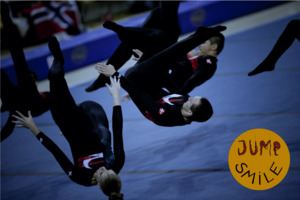For many years, fake smiles in female gymnasts have been the norm – and part of the “routine” during performance. However, lately, these “routines” have drawn negative public attention. Cases involving sexism, ruthless training culture and repression of female gymnasts have made headlines and given rise to considerations in gymnastic federations worldwide. Fortunately, the female gymnasts involved have risen against this oppression and sports culture. For example, the female German national team gymnasts at last year’s Olympic Games in artistic gymnastics chose to line up in suits with long legs to dissociate themselves from sexualization. In addition, gymnast star Simone Biles withdrew from the competition. She honestly and publicly shared that she was not mentally fit to compete and that she did not want to do something silly with the potential of getting injured, and the world’s athletes showed her their sympathy and solidarity.
In Denmark, there is a proud tradition within gymnastics. Every fourth year a giant sports festival takes place and gymnastics is the epicenter of the festival. Gymnastic teams with more than 200 gymnasts perform together, showing the diversity and solidarity in the unique Danish gymnastic culture – a culture that accommodates both the recreational and the elite gymnast. Moreover, it is a culture that to a great extent is based on volunteerism. Further, the distance from idea to action is short which is experienced both in the clubs and in the national Federation of Gymnastics, GymDanmark. Currently, GymDanmark has an ethical code where the objective is to create a value-based foundation that ensures mutual respect no matter where you are in the hierarchy. In addition, Danish Gymnastics & Sports Associations have allocated 9.4 million euro to encourage diversity in sport in Denmark. Gymnastics, however, is a sport where pain and injury of both traumatic and overuse nature is common. Currently, Danish gymnastic clubs experience challenges retaining adolescent gymnasts in the sport through the transition to adulthood, where up to 19% of the drop-out is caused by injuries.1
In this International Perspective we share some of our initial experiences from Denmark where we have been conducting one of the largest gymnastics injury surveillance studies, including more than 600 TeamGym gymnasts in both retrospective and prospective injury surveillance studies.
THE JUMPSMILE PROJECT
Looking at the various gymnastic disciplines, Team Gymnastics within rhythm and jump (TeamGym), is the most popular discipline in Denmark (Figure 1). Despite the increasing popularity, TeamGym has not received much attention from sports medicine and physical therapy researchers. Results from a study by Harringe et al. (2007) found in a small cohort of 42 senior gymnasts, from two top-level TeamGym teams that the incidence rate was 2 injuries per 1000 gymnastic hours.2 This is supported by another study, reporting 50 injuries per 1000 gymnastic hours in TeamGym competition.3
The JumpSmile project, from our research institution, aims to investigate and describe the injury epidemiology and risk factors in TeamGym. Results from the retrospective survey showed that in TeamGym gymnasts between 10-30 years of age, 80% suffer from musculoskeletal pain related to gymnastics during season, with approximately 2 injuries per gymnast and an average duration of 8 weeks per injury, suggesting a potential large injury burden from gymnastics injury (unpublished data). The majority of injuries were overuse injuries, and the total gymnastic exposure was high, with more than 7 hours on average per week for these athletes. While foot/ankle, knee, back and wrist injuries were the most commonly reported injury regions, these differed according to sex and body region, with especially the knee being a problem in the youngest gymnasts. Further, it is alarming that several gymnasts in the study and their parents have expressed that pain is an unavoidable part of the sport. Thus, the importance of focusing on training culture and beliefs, as well as developing effective injury prevention strategies within TeamGym gymnastic seems important. To address this challenge, the ongoing JumpSmile project in Denmark now prospectively follows more than 500 young gymnasts during a full season (10-11 months) to see if the data from the retrospective surveillance can be confirmed an further explained in a prospective injury surveillance set-up. This set-up includes: weekly SMS-track, telephone interviews and growth measures, in-depth knowledge about injury epidemiology, time-loss due to injuries and potential injury risk factors in the sport, such as exposure, growth spurt and joint hypermobility. Furthermore, a clinical examination will be offered by a physiotherapist to all gymnasts with an overuse injury that lasts more than 3 weeks, with a special focus on growth-related apophyseal injuries.
Hopefully, the JumpSmile project can contribute to the continued development of gymnastics, further education of coaches and new future injury prevention strategies, helping local gymnastic clubs in retaining their gymnasts. Thereby, many more true smiles in the future will see the light of the day and many positive stories and effects of gymnastics can be shared. Gymnastics is a sport that should include and exemplify joyful movement and physical activity – in a multicultural and diverse setting and culture - where fake smiles should not be necessary.
Funding
The authors have not declared a specific grant for this from any funding agency in the public, commercial or nor-for-profit sectors.
Competing interests
None declared
Patient consent for publication
Not required
Data availability statement
No data are available

